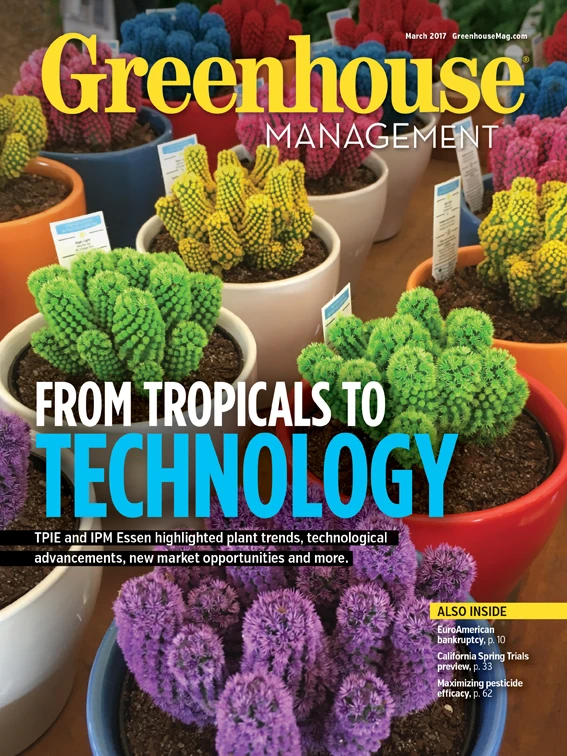
Cut flowers are a complicated topic for consumers who usually either love them or hate them. Some shoppers see cut flowers as a worthwhile item that fills their life with happiness and accept the temporary nature of the purchase, while others see them as a luxury item they can’t justify, a colossal waste of money, or even a guilt-inducing affront to their inability to keep things alive. Whew!
Faux or eco-unfriendly?
You’ve probably seen them going around . . . those Facebook ads for EcoFlower’s fake bouquets made of wood or perhaps some recycled materials. Many brides seem to have taken the bait and are going faux for their wedding arrangements. I can see how such products are a fresh take on fake flowers that can have broad appeal. Take a look at comments on related posts and you’ll see they often revolve around the perception that “fresh flowers are such a waste.”
Many people also see cut flowers as eco-unfriendly due to the resource inputs necessary to grow them, carbon emissions from their controlled production and shipping and their ultimate destination in a landfill. Given the overwhelmingly not-so-green lifestyles most of us are living, that’s frankly a hypocritical factor, but nonetheless, it’s a negative perception that impacts cut flower purchases.
If you grow locally or use sustainable methods, let your customers know. Step up your customer education and promotional efforts to align with socially and environmentally conscious consumer priorities. It’s important not only to market how and where your flowers are grown, but also what customers can and should do with them post-expiration to satisfy their green consciences and justify their purchases. Cut flowers are a compostable and recyclable product.

Given that there are far more serious environmental and landfill offenses besides your blooms, it’s important to dig deeper for the roots of why people pass on fresh cuts. Beyond cost and environmental concerns, impermanence and fear of failure feed customer reluctance to spend money on fresh flowers. Branding and content marketing strategies that tap into and resolve these concerns through education and personal customer experiences can shift attitudes.
Bringing flowers to the forefront
On the plus side, Instagram is heavily populated these days with flower artists who are successfully tapping into the happy zone that cut flowers can create in their customers’ lives. Those that do the best job of resonating with followers typically source their cut flower product locally or grow it themselves, to provide a product palette that changes constantly with the season.
If consumers want to go local, someone’s got to grow local. Local-to-local business relationships make good stories which, in turn, generate the type of marketing that better resonates with modern-day consumers.
Progressive floral artists are also pushing the boundaries of perception on what qualifies as typical floral product by incorporating edibles and wild collected materials into their creations. Their well-executed visuals and photography go a long way to delivering the right marketing message.
Along those lines, we must do a better job of developing the overall optics surrounding the value of cut flowers as a profession and a product. We Americans struggle with the best approach, but all you really must do is turn to the BBC for the right kind of inspiration. I’m admittedly addicted to European gardening programs and constantly bemoan the lack of such quality, plant-centric TV options here in the U.S. One such new program that recently caught my eye is the French reality show called “C'est Le Bouquet.” The show features 11 floral artists who compete each episode for the winning title. How cool is that? So very French. Why not so very American?
Personally, I don’t care to see another chef competition reality show for the rest of my life. Let’s just say I’m totally over the “chefs are gods” trend. Nevertheless, I must admit that the food industry has done a masterful job at putting those who cook our food on very high pedestals and leveraging that marketing power. The green industry should take a lesson. Bring on the flowers, I say!

Creating calm with colors
And finally, color trends for 2017. They can be summed up in one word: Muted. Fitting, no? I think that’s just about right considering the political and global unrest many are feeling. We can at least create some peace and calm in our personal space by choosing calming colors of décor and accenting with flowers to help tune out some of the chaos and maintain mental sanity. They don’t call a green room “a green room” for nothing.
Look this year for nature-inspired themes with assorted greens, muted oranges, chocolate browns, shades of gray, cream, calming blues and white to carry the day. Pantone’s 2017 Color of the Year “Greenery” will be a helpful marketing tool. (Editor’s note: Read more about Pantone’s “Greenery” at bit.ly/2lgaAll)
I’d say people are going to need a lot more flowers in their lives this year. Make the most of it. Peace, love and flowers, y’all.

Explore the March 2017 Issue
Check out more from this issue and find your next story to read.
Latest from Greenhouse Management
- Anthura acquires Bromelia assets from Corn. Bak in Netherlands
- Top 10 stories for National Poinsettia Day
- Langendoen Mechanical hosts open house to showcase new greenhouse build
- Conor Foy joins EHR's national sales team
- Pantone announces its 2026 Color of the Year
- Syngenta granted federal registration for Trefinti nematicide/fungicide in ornamental market
- A legacy of influence
- HILA 2025 video highlights: John Gaydos of Proven Winners





